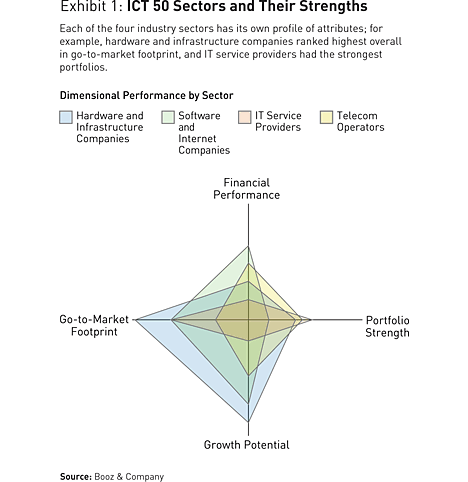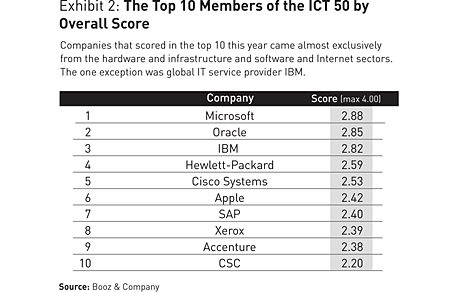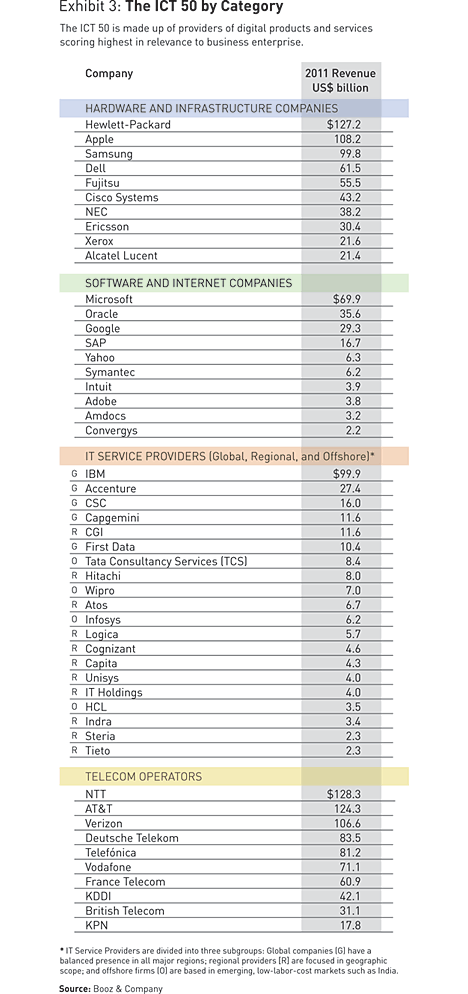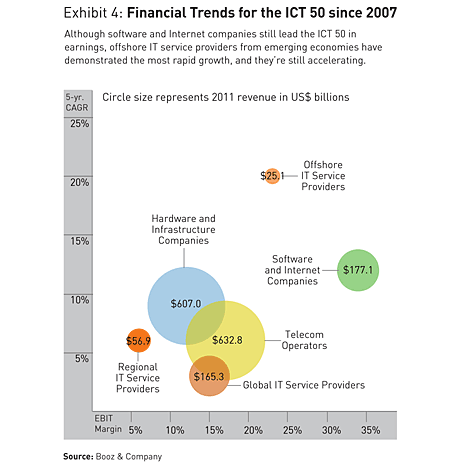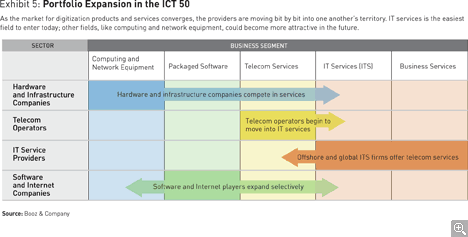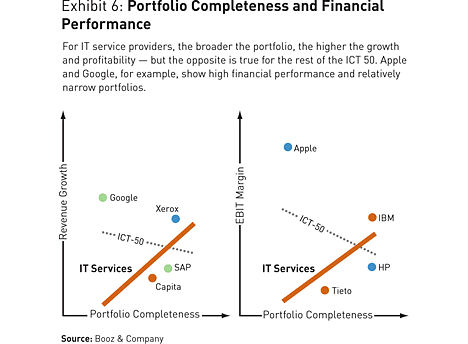The Global ICT 50: The Supply Side of Digitization
The top 50 companies providing IT and telecom hardware, software, and services are facing dramatic change and convergence. Their response will transform life for the rest of us.
Driven by a combination of consumer demand and the development of new information and communications technology (ICT), the world is rapidly transforming. This process, called digitization, has been happening since the arrival of the computer 60 years ago, but in the past few years it has accelerated, altering everyday life in unprecedented ways. Technological developments such as handheld devices, pervasive sensors, “big data” analytics, digital supply chains, search engines, social networks, satellite-based geographic tracking, interconnected real-time digital infrastructure, and massive server farms have fundamentally altered our society. The 2010s are arguably as different from, say, the 1980s as 1950, with ubiquitous electricity, automobiles, and broadcast radio, was from 1850.
Digitization is being driven in part by the companies that make use of digital infrastructure and in part by consumers around the world. The enterprise market for online IT and digital telecom is booming — corporate sales worldwide grew 6 percent annually in 2010 and 2011 — while the market for consumer-oriented devices and services (including cloud-based online IT services) grew even more rapidly. At the forefront of change is Generation C, people born after 1990 who expect to be connected to everyone, everywhere, at home and at work. As members of this group come of age, moving into managerial ranks or starting their own businesses, the tools and habits of digitization will become second nature.
One might expect that because society is increasingly dependent on digital products and services, the producers of digitization would be affluent, assured of success, and complacent. But their industry is undergoing a parallel transformation, and it is not clear how many companies will last in their current form. The traditional sectors of the ICT ecosystem — a multi-trillion-dollar industry whose members include enterprise service providers, hardware producers, telecom companies, and software developers (including the purveyors of Internet services and social media) — are blurring and converging. For example, telecom, hardware, and software companies are moving into IT services. Offshore IT service providers are developing enterprise software, often in the form of low-cost, highly standardized systems delivered via the Internet, designed to take over large portions of the work of traditional corporate IT departments. The industry is also being invaded by a host of hungry new Internet players, who offer innovative Web-based solutions that bypass the systems of the past. In this context, even the wealthiest, most successful ICT providers, like Microsoft in the 1990s, Google in the 2000s, and Apple today, cannot be certain of sustaining their success. The title of the first book by former Intel CEO Andrew Grove — Only the Paranoid Survive — has never seemed so telling a comment on this industry.
How will the process of digitization play out? How will it affect the companies vying to supply these technologies, particularly in the business-to-business domain? The answers are essential for decision makers in any company, no matter its industry. The choice of ICT goods and services is a critical strategic factor: It deeply influences the quality and distinctiveness of a company’s capabilities. That choice, in turn, depends on a clear assessment of the future of these providers. It is all too easy to get locked into a technology system that will not be sustained in the marketplace.
At a more exalted level, the leading digitization providers are among the most influential companies of our time, and their influence is increasing. Their digital channels shape behavior for all other businesses and, indeed, for a great deal of human interaction.
Finally, these companies are a fascinating group in their own right. Some, like Hewlett-Packard (HP) and IBM, have existed for many decades, continually reinventing themselves; others are relative newcomers. Each, in its own way, has mastered innovation and struggled with disruption. Their story is our story.
Anatomy of the ICT 50
In early 2012, a group of Booz & Company researchers evaluated the 50 largest publicly traded global suppliers of information and communications technology products and services to enterprise: the “Global ICT 50.” We assessed how well they are doing now and how prepared they are for the changes that lie ahead, and then we ranked them according to their enterprise relevance: their potential importance to company value chains, in the present and the near future. Four qualities come together to make up this score:
• Financial performance: Which companies can best sustain the profitability needed to make the investments that will help them win the digitization race?
• Portfolio strength: Which companies possess the best mix of business-to-business products and services, given the demands of digitization?
• Go-to-market footprint: Which companies have established sales and delivery capabilities in the top markets for ICT?
• Growth potential: Which companies have the three factors needed today for expansion in this industry: prowess in innovation, presence in emerging economies, and the ability to attract new customers?
With assessments of these four qualities based on publicly available information, we ranked the trajectory of performance for the leading companies in the four main sectors in this industry.
1. Hardware and infrastructure companies. This sector, which includes Apple, Hewlett-Packard, Dell, Cisco Systems, and Xerox, has traditionally been the core of the technology industry. Although their hardware systems have often been complementary (Cisco produces the routers that connect HP’s printers to Apple’s tablets and Dell’s computers), these companies have long been perceived as being in the same business. Now they are striving to build more differentiated businesses, branching out into software and services, while retaining core businesses built around ever more powerful and affordable equipment.
2. Software and Internet companies. This sector includes Microsoft, Google, Oracle, and SAP, and it is positioned to do well in a highly digitized world. Some of these companies are very large, giving them the strength to compete successfully in digitization (and in many cases, as with Microsoft and Google, to branch out into hardware). Others are smaller, but focused and capitalized enough to lead the industry. The small players’ products tend to be specialized or distinctive, giving them relatively protected platforms from which to expand.
3. IT service providers. Having established themselves over the past 30 years as technology concierges to large- and medium-scale enterprises, these companies offer a variety of services: hosting computers and networks, managing computer applications such as databases, and integrating hardware and software. This sector has three subgroups, each with its own business dynamic. The first is global companies, such as IBM, Accenture, and CSC. They have parlayed their scale into industry leadership positions. Second is regional service providers, such as Atos in France, Logica in the U.K., and Unisys in the U.S., which face a more challenging future. Some are using M&A to increase their scale and market share; for example, Atos bought Siemens IT Solutions and Services in 2011, to create what the announcement called a “European IT champion.” The third subgroup consists of offshore IT service providers based in India, including HCL, Infosys, and Wipro. Starting from a relatively low base, these companies have shown the strongest growth of all the ICT 50 in recent years — more than 15 percent annually, even through the global economic downturn.
4. Telecom operators. Hundreds of companies bring telecommunications — a combination of mobile, landline, Internet, and television — to homes and offices around the world. The most prominent include NTT, Telefónica/O2, and Verizon. This sector faces the largest challenge of the four: Many companies still have significant amounts of cash on hand, but much of it is being consumed by ongoing investments in network infrastructure and in dividend commitments. And not all of them are funneling investment into innovation and new capabilities, such as IT services.
Each of these sectors has its own combination of qualities, with different competitive strengths and weaknesses. (See Exhibit 1.) Despite their differences, however, all the members of the ICT 50 have one thing in common: They share a context that has shifted markedly during the past few years, and not just because of the global economic downturn. Earlier waves of information and communications technology, during which businesses fulfilled their basic needs for connectivity and computing power, have effectively run their course. The two critical infrastructure elements required for digital media — computer power and Internet access — were established in the 1990s, were rolled out across the world in the 2000s, and are now commodities throughout most industries.
The most recent wave of digitization began around the time the iPhone was introduced (in 2007), and has picked up speed since 2010. With the basic infrastructure in place, both businesses and consumers are demanding more from software and services. The mobile handheld device has become an all-purpose digital gateway; employees increasingly demand to use their own devices for work, which gives them the flexibility to mix their personal and working lives, and the continued expansion of their personal and social networks. As digitization takes hold, the boundaries between departments — and between companies — become looser and more permeable than they have ever been before. Supply chains integrate using cloud-based applications; marketers aggregate data from online sources, including social media. In all these ways, and more, sophisticated new services have rapidly and offhandedly moved into the business world, where they are disrupting the ICT market.
The changing nature of the demand for ICT products and services helps explain why the supply side of digitization is in flux — with more volatility than at any time since the collapse of the dot-com bubble in 2000. The Global ICT 50 study was designed to provide an analytical portrait of that volatility. To our knowledge, it is the first study to examine enterprise relevance for all four sectors together. If some of the rankings seem counterintuitive, that’s because the business-to-business emphasis leads to assessments very different from those of the typical technology press. For example, Apple, with its notable success and high market capitalization, is ranked below HP and Cisco Systems. Google is not even included in the top 10. (See Exhibit 2.) Apple and Google are both remarkable, extraordinarily capable companies, but their impact on corporate ICT purchasing remains relatively low, no matter how many iPads or search engine advertisements are sold. If you are a CIO or an ICT decision maker designing your organization’s approach to digitization, the companies at the top of each category are the ones that are likely to be most relevant to you. (See Exhibit 3.)
Financial Performance
Where financial performance is concerned, the ICT 50 analysis confirms that one prevailing assumption of the past decade — “service rules” — no longer holds true. None of the top five financial performers were IT service providers or telecom operators. The software and Internet companies Microsoft, Google, and Oracle had the greatest overall financial health, followed by the hardware and infrastructure companies Apple and Cisco Systems. (The score combines several published measures: profitability, revenue growth, and investment capability.)
The hardware and infrastructure sector experienced a slump during the economic downturn, but it has recovered since 2010, with three-year revenue growth of more than 11 percent. Margins, however, are comparatively low, at just 12 percent on average, and these companies face tremendous pressure as digitization expands. This pressure was highlighted in May 2012 when Hewlett-Packard announced it would cut more than 7 percent of its workforce and reinvest the savings in cloud-based businesses.
As a whole, the software companies have the most enviable financial performance, at least for the moment. They have seen overall three-year revenue growth of more than 10 percent, and their margins have long been higher than 30 percent — higher than those of any other group. But they may soon face global rivals among the offshore service providers, who have by far the fastest growth rate and impressive EBIT (earnings before interest and taxes) margins of more than 20 percent, on average.
Global service providers are also doing well; they maintain margins around 15 percent, and IBM generates more than US$15 billion in free cash flow each year. Regional service providers are in a more daunting position: With only mild revenue growth in the last two years, and margins in the 5 to 8 percent range, they may soon find themselves with little room to maneuver. Telecom companies are also stressed financially, but for a different reason: Comparatively stable and with relatively high earnings, they find that their growth has leveled off since the financial crisis of 2008 and shows no sign of renewed liftoff. (See Exhibit 4.)
Portfolio Strength
In the past, each group of ICT suppliers stayed well within their closely guarded sector boundaries. Software companies sold software, and telecom operators built communications networks and sold phone services. The four groups are still distinct, but not necessarily for long. Both traditional and nontraditional ICT companies are consolidating, seeking to build integrated ecosystems that cut across established business models and help them manage convergence.
The pattern of mergers and acquisitions provides a tangible clue to the direction in which companies are moving. In 2009, hardware company Xerox acquired Affiliated Computer Services, a business process outsourcing firm, thereby accelerating Xerox’s shift to IT services. Dell bought IT services provider Perot Systems the same year, with similar intent. Other acquisitions, like Oracle’s 2010 purchase of Sun Microsystems, represent moves toward more complete software integration (adding a little hardware to the mix as well). These types of consolidations allow software companies, which were formerly concentrated on specific applications, to internalize larger parts of systems integrators’ traditional home turf and hold the line against IT service providers.
Launches of new products and services also frequently represent moves across sector boundaries. (See Exhibit 5.) Some telecom operators seek a foothold in cloud computing and IT services; Verizon’s cloud-based infrastructure-as-a-service offering is one example, as is KPN, which provides application management services to its customers. Software and Internet companies are also innovating across boundaries, albeit more selectively. Yahoo, for example, offers comprehensive Web hosting but has stayed out of data center services and desktop operations.
The companies most likely to cross boundaries are the IT service providers. IBM, for example, offers its Sametime Unified Telephony service, which includes telephony features for individual users and multi-PBX telephony integration for telephony managers, and CSC offers Unified Communications as a Service as well as My Conference Space, an integrated audio and Web conferencing solution.
Besides this ability to manage convergence, the score reflects the ability to provide next-generation products and services. Many companies are blending traditional offerings with new, highly advanced technological services, including radio frequency identification solutions for retail, near-field communications solutions, cloud computing, and mobile payment platform support. Unfortunately, the profits and growth expected from next-generation offerings have not yet materialized. Most companies still earn more from classic ICT products and services; the next few years will tell how rapidly their customers will shift to next-generation technologies.
Two other capabilities figure in the score for portfolio strength. First is the development of horizontal digital offerings for particular functions. Companies in the ICT 50 offer such specialized services as customer analytics, digital marketing, campaign management, billing services, sales-force automation, social network integration, supply chain logistics, and e-procurement to company after company. Second is the provision of vertical offerings: tailored, industry-specific technological solutions that work across functions. Current examples include outsourced network management for telecom; clinical information systems, digital health monitoring, and home-care products for healthcare companies; and smart metering systems for utilities. In both the horizontal and vertical cases, the key value proposition appears to be integration; large companies are looking for ICT providers that can weave many diverse services around a coherent, focused, interoperable core.
Some might assume that the industry is moving toward a consolidated group of comprehensive “one-stop” ICT companies with diversified portfolios. In three categories out of four, however, the results suggest otherwise: Companies with higher levels of coherence, applying the same capabilities to all their offerings, have higher levels of growth and profitability than do more diversified companies. The exception, at least to date, is IT service providers; that may change as their category converges and matures. (See Exhibit 6.)
Go-to-Market Footprint
Commentators often overlook a company’s geographic profile — especially its ability to sell and deliver products and services in the industry’s top markets. But this capability is critical to the success of any ICT company with global aspirations. That’s especially evident in the five most highly developed ICT markets — the U.S., the U.K., Japan, Germany, and France. These countries saw combined sales of $1.2 trillion in 2011, more than 60 percent of total global sales of ICT services. Being proficient in sales and delivery in these markets certifies the ability of ICT players to satisfy the needs of the largest corporations. And these markets offer a source of revenue and a profit pool that is too big to be ignored.
The offshore IT service providers are pushing hard to establish a foothold in these markets, which have not necessarily been their natural operating environment in the past. Tata Consultancy Services already has more than 600 employees in Germany alone. We expect to see more aggressive investment and acquisition activities by these companies, which will increasingly compete (or form strategic partnerships) with regional IT service providers.
The go-to-market footprint score also takes into account the ability to manage production facilities around the world, drawing on inexpensive labor, as well as “follow the sun” delivery (where a project is handed off daily from one time zone to the next, thus providing 24-hour scheduling). This type of global production is particularly challenging for many telecom operators. They are bound to their local markets by their existing infrastructure investments, which severely limits the efficiencies they can gain in other locations, and by the inherent complexity of combining offshore and onshore operations. Telecom companies also face more regulatory restrictions than the other sectors. This explains a striking correlation in the data for telecom operators: The more offshore activity they engage in, the less profitable they are.
The opposite is true for IT service providers. The more their operations move offshore, the higher their profitability. Regional IT service providers may feel some disadvantage; they lack the capabilities and capital to break into emerging markets. But the offshore providers are already familiar with many emerging markets, and they have been able to realize savings from lower workforce costs. Global providers also do well on this score; they have established successful production facilities (and the requisite talent practices to staff them) around the globe. Companies such as IBM, with delivery centers worldwide, and Capgemini, whose workforce is distributed among 40 countries, are significantly more profitable than those whose production takes place primarily in high-wage countries. (We saw little or no correlation effect with the other two groups, presumably because hardware and infrastructure companies, and their software and Internet counterparts, have more flexible geographic and labor requirements.)
Growth Potential
For a digitization provider, the prospects for growth are as important as current-day financial performance. The growth potential score is heavily weighted by each company’s ability to innovate: to maintain an active pipeline of new ideas and bring them to market successfully.
The most visible ICT 50 innovation leaders are found in two of the four sectors: software and Internet companies, and hardware and infrastructure companies. These companies typically spend a considerable portion of their revenues on research and development, and even those that spend well below their group average, most notably Apple, tend to spend their innovation dollars wisely. In addition to investing in its traditional devices and components business, Fujitsu spends almost half of its $2.8 billion R&D budget on IT products, solutions, and services. And Xerox has invested considerable funds in its Computing and Information Services Laboratory, where it investigates scalable computing for business process solutions and big data analytics.
By contrast, most of the IT service providers do not have the margins needed to invest in R&D at high rates, and (with the notable exception of IBM) their innovation takes a more modest form. They see themselves as integrators, continually researching ways to link the products and services produced by other companies. As for the telecom operators, they continue to spend much of their funds on recurring infrastructure and network upgrade commitments, limiting the amount of capital available to innovate in more value-added services.
The growth potential score also reflects each company’s ability to enter new markets — both within established geographies (such as selling to small and midsized enterprises or governments) and in new regions. Notwithstanding their current importance to the go-to-market footprint score, the five most highly developed ICT markets grew just 1 percent on average over the past three years, and their long-term growth prospects are not particularly strong. The BRICs (Brazil, Russia, India, and China), on the other hand, currently account for only $186 billion in ICT sales, but they grew 13 percent on average per year from 2009 to 2011. By 2020, the BRICs will be markets in which every ICT player must operate.
Predictions and Prescriptions
For companies buying ICT services, the convergence of the ICT 50 promises to be very exciting. As the ICT 50 companies compete across boundaries, winners will emerge that are more innovative, more responsive to customers, and able to deliver more at lower costs. But how should the different sectors position themselves?
In general, the hardware and infrastructure companies have demonstrated relatively strong financial performance, with a well-developed go-to-market footprint and robust growth potential. Their greatest priorities should be finding a business model that works for them and increasing their portfolio strength. Much will depend on how well these players capitalize on the next generation of on-demand services. They will be the providers of the underlying infrastructure that enables real-time computing, in-memory processing, and more; they will also need to forge differentiated, profitable offerings by acquiring or partnering with connectivity and network providers. Apple is currently developing a closely guarded closed-service ecosystem, but other, more open system approaches may also be viable. New types of challengers, such as Amazon, will probably enter the ICT 50 soon; Amazon’s Web services business is built on a highly flexible, scalable data center and computing infrastructure.
The telecom operators boast consistently high financial performance and a strong portfolio of critical communications products and services, but their core business is maturing and faces commoditization. To sidestep this, they must expand their go-to-market footprint through acquisitions or strategic partnerships, push for operational excellence and efficiency within the constraints imposed by physical network assets and local regulation, and develop a truly differentiating portfolio of services that will take them beyond their traditional telecom offerings. Some companies, notably Verizon and NTT, with their strong cloud offerings, are beginning to make these moves. But after paying for the next generation of network infrastructure, they have limited funds for further innovation, and their growth potential is constrained. They may seek additional partnerships or mergers as a vehicle for growth.
The strength of the IT service providers varies, depending on their size, financial performance, and go-to-market footprint. In the short term, consolidation within this sector will continue — as demonstrated by CGI’s recent acquisition of Logica. Market share and scale alone, however, will not differentiate these companies or guarantee profitability; the firms will need to bolster their growth potential through innovation and stand their ground in competition against the other ICT 50 sectors. The changing nature of system integration will keenly affect them; as custom-integrated enterprise software solutions lose ground to prepackaged cloud-based solutions and as software players absorb some of the traditional system integration business, IT service providers will need to build portfolio strength by developing their integration capabilities.
Many offshore IT service companies are already moving in this direction. They are using their industrialized delivery capabilities and low-labor-cost advantages to compete against such global players as IBM, Accenture, and HP. They will seek aggressive expansion into the lucrative markets of mature economies; the challenge for them will be to do so while remaining true to their low-cost, offshore roots.
Finally, the software and Internet companies on the ICT 50 are financially sound and highly innovative, with generally strong portfolios and a great deal of growth potential. They should expand, but only into areas that differentiate them. Microsoft, Oracle, and SAP are in a strong position today, and they are working hard to stay there. But “digital native” players are pushing aggressively into the arena, especially in cloud computing and social media. Expect digital-centric players such as Google to move up in the software ranks, and look for more cloud-based software companies to follow older firms like Salesforce.com into prominence.
In most industries, it takes a long time for companies to change the way they operate. But many members of the ICT 50 have already shown themselves to be fast-moving and flexible. Next year, when we look again at the industry, we suspect that much will have changed; we may well see 10 newcomers among the ICT 50. But the biggest winners will undoubtedly be those that, like IBM, Microsoft, and Oracle (this year’s top three), combine flexibility with a distinctive core identity that no one else can duplicate. ![]()
Methodology
For this study, we analyzed the 50 largest publicly traded companies in the ICT supplier industries on four measures: financial performance, portfolio strength, go-to-market footprint, and growth potential. (See Exhibit 7.) Our analysis was based on a combination of publicly available financial data and a qualitative assessment of the capabilities of each player, conducted by a panel of Booz & Company ICT sector experts.
In making this assessment, we used clearly defined criteria to investigate the relative strength and strategic positioning of each company in each of the four dimensions. Consolidated scores for each company were determined on a scale from 0 to 4. Events that became public knowledge after April 2012 — such as CGI’s announcement of its plans to acquire Logica — occurred after we collected the data for the 2012 Global ICT 50 study and are thus not reflected in the results.
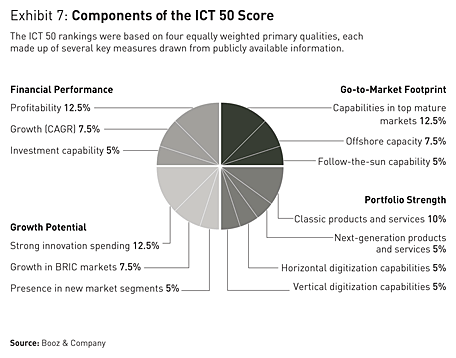
Reprint No. 00119
Author profiles:
- Olaf Acker is a partner with Booz & Company based in the firm’s Frankfurt and Dubai offices. He focuses on business technology strategy and operating model transformation programs for global companies in the telecommunications, media, and high-tech industries.
- Florian Gröne is a principal with Booz & Company based in Berlin and New York. He heads the firm’s CRM Center of Excellence in Europe, and works with telecom, IT services, and consumer products companies on their path to digitization.
- Germar Schröder is a principal in Booz & Company’s Frankfurt office. He focuses on communications clients and ICT service providers, and has led several initiatives for product development, go-to-market, and operating model design, specifically for the cloud.
- Also contributing to this article were Booz & Company senior associate Hans Geerdes and contributing writer Edward H. Baker.



